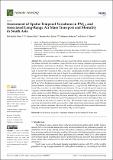| dc.contributor.author | Islam, Md Sariful | |
| dc.contributor.author | Roy, Shimul | |
| dc.contributor.author | Tusher, Tanmoy Roy | |
| dc.contributor.author | Rahman, Mizanur | |
| dc.contributor.author | Harris, Ryley C. | |
| dc.date.accessioned | 2023-10-27T19:16:44Z | |
| dc.date.available | 2023-10-27T19:16:44Z | |
| dc.date.issued | 2023-10-16 | |
| dc.identifier.uri | https://hdl.handle.net/1721.1/152535 | |
| dc.description.abstract | Fine particulate matter (PM<sub>2.5</sub>) is associated with adverse impacts on ambient air quality and human mortality; the situation is especially dire in developing countries experiencing rapid industrialization and urban development. This study assessed the spatio-temporal variations of PM<sub>2.5</sub> and its health impacts in the South Asian region. Both satellite and station-based data were used to monitor the variations in PM<sub>2.5</sub> over time. Additionally, mortality data associated with ambient particulate matter were used to depict the overall impacts of air pollution in this region. We applied the Mann–Kendall and Sen’s slope trend analysis tool to investigate the trend of PM<sub>2.5</sub>. At the same time, clustering of backward trajectories was used for identifying the long-range air mass transport. The results revealed that the mean annual PM<sub>2.5</sub> mass concentration was the highest (46.72 µg/m<sup>3</sup>) in Bangladesh among the South Asian countries during 1998–2019, exceeding the national ambient air quality standards of Bangladesh (i.e., 15 µg/m<sup>3</sup>) and WHO (10 µg/m<sup>3</sup>), while lower PM<sub>2.5</sub> was observed in the Maldives and Sri Lanka (5.35 µg/m<sup>3</sup> and 8.69 µg/m<sup>3</sup>, respectively) compared with the WHO standard. The trend analysis during 1998–2019 suggested that all South Asian countries except the Maldives experienced an increasing trend (<i>p</i> < 0.05) of PM<sub>2.5</sub>. The study showed that among the major cities, the mean annual PM<sub>2.5</sub> value was the highest in New Delhi (110 µg/m<sup>3</sup>), followed by Dhaka (85 µg/m<sup>3</sup>). Regarding seasonal variation, the highest PM<sub>2.5</sub> was found during the pre-monsoon season in all cities. The findings of this research would help the concerned governments of South Asian countries to take steps toward improving air quality through policy interventions or reforms. Moreover, the results would provide future research directions for studying the trend and transport of atmospheric PM<sub>2.5</sub> in other regions. | en_US |
| dc.publisher | Multidisciplinary Digital Publishing Institute | en_US |
| dc.relation.isversionof | http://dx.doi.org/10.3390/rs15204975 | en_US |
| dc.rights | Creative Commons Attribution | en_US |
| dc.rights.uri | https://creativecommons.org/licenses/by/4.0/ | en_US |
| dc.source | Multidisciplinary Digital Publishing Institute | en_US |
| dc.title | Assessment of Spatio-Temporal Variations in PM2.5 Associated Long-Range Air Mass Transport and Mortality in South Asia | en_US |
| dc.type | Article | en_US |
| dc.identifier.citation | Remote Sensing 15 (20): 4975 (2023) | en_US |
| dc.contributor.department | Massachusetts Institute of Technology. Media Laboratory | |
| dc.identifier.mitlicense | PUBLISHER_CC | |
| dc.eprint.version | Final published version | en_US |
| dc.type.uri | http://purl.org/eprint/type/JournalArticle | en_US |
| eprint.status | http://purl.org/eprint/status/PeerReviewed | en_US |
| dc.date.updated | 2023-10-27T10:26:58Z | |
| dspace.date.submission | 2023-10-27T10:26:58Z | |
| mit.license | PUBLISHER_CC | |
| mit.metadata.status | Authority Work and Publication Information Needed | en_US |
